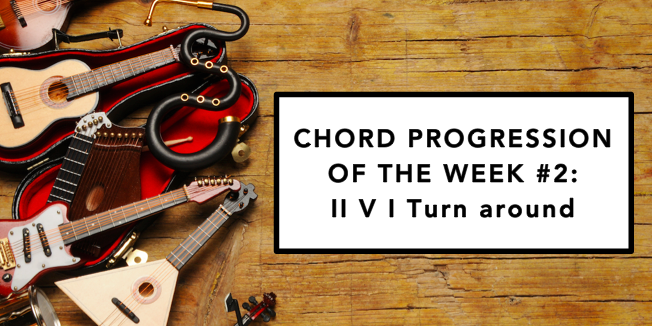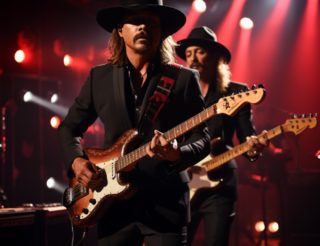Chord Progression of the Week 2: ii V I turn around
Author: Miguel Marquez

Welcome to the second instalment of this new series of articles where I take a famed chord progression and show you different ways to integrate it into your repertoire. This particular article is about a chord progression that can be seen as both a chord progression or as a turnaround that happens within a longer succession of chords. In that sense, I’m sure you’ve played a song previously that contains this turnaround, and you didn’t even notice. The progression in question is the famed ii V I turnaround that can be heard in so many Jazz standards, but is also present in several folk songs. At the first glance, it might not seem that interesting due to the minimal amount of chords.
In today’s article, we’ll analyse this turnaround in the key of D major. The chords would thus be Emin Amaj and Dmaj.
In order to make the turnaround sound more jazzy you’d use tension notes so you’d end up with Emin7 A7 Dmaj7 in the simplest version:
Obviously you can take it further and play Emin7 A9 Dmaj7.
There are several other alternatives, some of which sound pretty cool. We’ll definitely be going through those.
Table of Contents
Where can it be heard?
Several jazz standards make heavy use of the ii V I chord progression. It is in my opinion “the” jazz turnaround and indeed you’ll find lots of ii V I progressions in any real or fake book. You can hear the ii V I it within Chick Corea’s gorgeous composition “Spain”, or in Frank Sinatra’s “Fly me to the moon”.
The cool thing about this progression is how well it lends itself for several tricks, such as chord substitutions, tritone substitutions, hyperchords, modulations…
Why does it work?
The chord progression at hand is made up by diatonic chords that together form a sequence of V I cadences or rather as a succession of chords where the root of one chord is always one fourth below the root of the chord that follows:
Emin Amaj Dmaj
Emin Amaj: v/V V/I
Amaj Dmaj: V I
What can I do with it?
Something that you can do is to add a tritone substitution after every single chord. Say you’re playing the ii V I turnaround in the key of B minor as shown above. Instead of just playing Emin Amaj Dmaj or Emin7 A7 Dmaj7 (for the sake of making it sound a bit more jazzy), you can then have Emin Bb7b5 Amaj7 Eb7 Dmaj7
Something that I like to do is alter the I chord and turn it into a dominant chord that leads to the ii. This works best if the ii chord has a seventh in it:
Emin7
A7
Dmaj: D F# A
D9: D F# A C E
Emin7: E G B D
As you can see, theoretically we have the D9 leading towards the G major triad contained in the Emin7 chord.
Another trick that renders the chord progression more rich is to add a secondary dominant before the ii chord. So you’d have:
Balt (V/ii) Emin (ii) A7 (V/I) Dmaj7 (I)
That secondary dominant alone lends the progression a vibe that is very common in Latin jazz.
You might object that the addition of new, non-diatonic chords to the equation might admittedly be regarded as not only an expansion but also a radical change from the sound of the ii V I progression. Nonetheless, notice how we’re still moving in terms of fourths from chord to chord or rather using secondary dominants and substitutions in order to enrich the ii V I progression.
This is not an article on improvisation, but allow me to make a modest proposal: create loops of each of the examples listed and improvise on top of them. You’ll soon notice how creative you can get on top of this progression. Check out our Beginners Guide to Jazz Improvisation over here if you’re interested. You’ll also understand why it’s a favourite of Jazz musicians.








I have read many of miguels articles and listened to his soundcloud, although he is talented he is generally delusional and uninformed, pretending to be an educator but is really just a guy with a guitar who plays some beautiful licks…I find his writing to be very immature and it sounds like someone who is a poser and pretender, i wish he would do some real study and stop his nonsensical musings
Hey Jones, while I’m happy about any reader engagement, I would prefer if we could still be nice to each other. I believe Miguel is doing a pretty good job in general, so it would be great if your criticism could be a bit more substantial instead of just giving us a list of unqualified adjectives.
Now this aside, you seem to be knowledgable, so would you like to write an article for us?
I think this is a confusing article mainly because a “ii V I” in the key of B minor makes no sense and it may be a typo. The key is D major. Which is the following notes : D E F# G A B C#
By following the roman numeral it would be : I ii iii IV V VI making the 2 5 1 he is trying to teach Eminor Amajor Dmajor.
Thanks for pointing that out. It was indeed a typo.